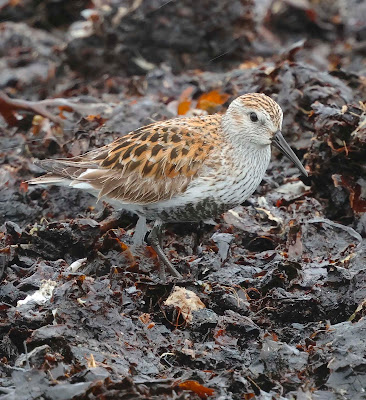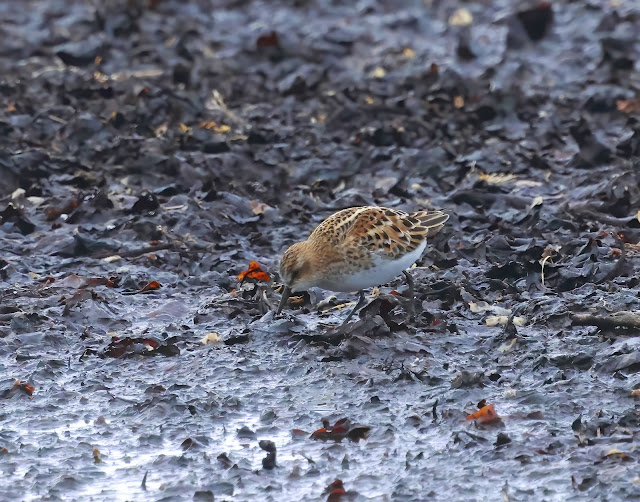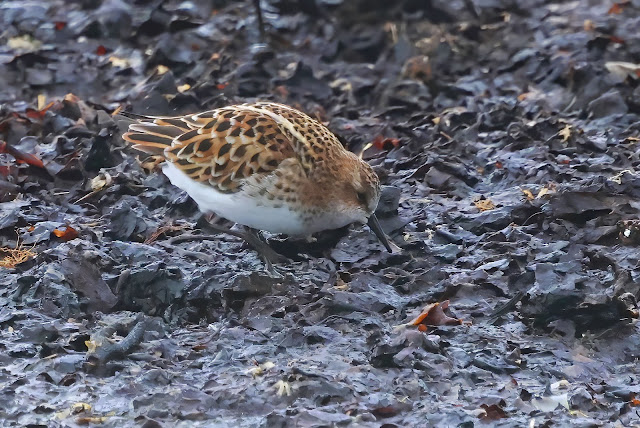This is Scotland so such a situation with the weather was hardly unexpected and, after all, there was no reason to feel dispirited as we already had experienced some days of beautiful weather and still have two more weeks to go on Arran. Staying in the house was not an option so we made a plan to drive to Blackwaterfoot that lies half way down the west side of the island to visit the Old Bakehouse that we have come to know well due to its attractive array of pastries, bread and now with coffee as an added temptation.
The drive to Blackwaterfoot is on a virtually deserted road alongside the Kilbrannan Sound, the rocky shore for the most part never more than a few metres from the road.
 |
| Oystercatcher |
Much smaller is the Common Sandpiper that stands sentry on a large rock by the seashore while its mate incubates four eggs, hidden in a nest in long grass and dense vegetation nearby, often on the landward side of the road.Once the eggs hatch the parent birds will lead the precocious young to the shore to take their chances.
 |
| Common Sandpiper |
 |
| Black Guillemot |
 |
| Common Gull |
The month of May has brought to this part of the island a profusion of growth as the bracken begins to unfurl its green fronds below the prolific birch trees that grow on the hillsides rising up from the road. The cerise pink flowers of Red Campion bring a pleasing variance to the omnipresent green of the roadside verges. Foxgloves, each plant a crooked spire of multitudinous purple flowers, its tip bent over like a beckoning finger rise above the bracken in pockets of profusion while flag iris raise brilliant yellow, floppy petalled heads from green fleshy stalks in the wetter areas of field and ditch.
This is all to the good as at this time of year it attracts migrating birds such as White Wagtails, Northern Wheatears and especially waders, the rotting weed providing a home for countless invertebrates and an invaluable source of food for the birds.
Of wading birds, I have seen Whimbrels here as well as Turnstones, Ringed Plovers, Dunlins and Common Sandpipers. Many are breaking their journey to feed up in order to head further north to their breeding grounds in the Arctic Circle.
Today brought a most pleasant surprise as the blackened expanse of seaweed was covered with more waders than usual, swarming like restless ants across its surface. Checking in my bins many appeared to be very pale, especially when seen against the blackened seaweed.They could only be one thing, Sanderling, my favourite waders. I looked through the flock busily picking invisible prey from the rotting weed. Sanderling in Spring display a bewildering variation in plumage, no one individual quite the same as any other.They vary from grey and white to a rich orange chestnut and this flock was typical with birds showing varying degrees of colour saturation from both ends of the spectrum.
Why this is so is a matter of speculation.On the one hand it may be that the richer coloured birds are older individuals or that some birds never achieve the rich orange colouration at all whilst another suggestion is that birds on migration curtail their moult and only acquire their rich colours when they arrive at their breeding areas.
 |
| Sanderling |
I counted through the Sanderling a number of times, no easy task as they were constantly and haphazardly moving about at speed but finally I settled on a very good count of thirty and a delight to find on this miserable morning.As one inevitably does I checked and re-checked their number to see if I could get a higher count than thirty.
It was on my last count that I got thirty one. I looked more intently and found an individual that looked a slightly brighter orange than any other of its companions. It also displayed two very distinctive buff lines forming an inverted v running down its back. I realised I had discovered a summer plumaged Little Stint.
 |
| Little Stint |
Once onto it I noted its more rapid erratic movements and when it came close to a Sanderling how much smaller it was in comparison.
When seen on its own its diminutive size (it is one of the world's smallest waders) was less obvious but the quicker feeding action and richer colouring gave it away as did the two buff braces one on either side of its mantle.
It scurried back and fore, always on the fringe of the feeding Sanderlings, constantly picking minute prey items from the weed. It was never still, forever feeding, doubtless using the weather intervention to replenish its energy reserves. Soon it will have to head onwards to breeding grounds that can be anywhere in the Arctic Circle from northern Scandinavia, the Russian Arctic islands of Novaya Zemlya or across northern Siberia where it will breed in a brief window from mid June to August, whilst the Sanderlings will head for Siberia or northwest to Greenland, maybe via Iceland.
Little Stints migrate over 7500 miles from their winter homes on either European and North African Mediterranean coasts or sub Saharan Africa to the Arctic Circle and then back again.
How do they manage this almost miraculous and perilous journey but manage they do.
I took many images of the Little Stint, some good some not so. By this time despite the rain I had abandoned the car to sit on a bench, getting thoroughly soaked in the process.It was singularly unpleasant but the stint was worth it. The last Little Stint to be seen on Arran was in September 2002 so this was a truly momentous birding event for Arran and, it has to be said, for me also.
Periodically the birds would take alarm and fly in a tight fast flying flock out over the sea before wheeling in unison to come back to land and recommence their frantic feeding. The seaweed was obviously a goldmine of food and the flock after landing further down the beach would always return there on rapid twinkling feet as soon as they felt safe to do so.
Other waders fed amongst them, Ringed Plovers, both migrant and local individuals, while half a dozen Dunlins, only slightly bigger than the stint, wandered amongst the larger Sanderlings.
 |
| Ringed Plover |
 |
| Dunlin |
Turnstones looking almost thuggish in comparison due to their larger more robust build were vigorously turning over the seaweed with their short stout bills, looking for prey. Most were still in either non breeding plumage or still had to progress their moult to its summer finery but one or two were almost there in their attractive harlequin breeding colours.
 |
| Turnstone |
I forgot about the rain and the inevitable inconvenience and frustration it brought as I continued to watch the birds feeding below me.
A Little Stint on Arran.Who would have suspected that after twenty two years?
The Little Stint was last seen on the 30th May


.jpg)
.jpg)
.jpg)
.jpg)
.jpg)


















.jpg)

.jpg)
















